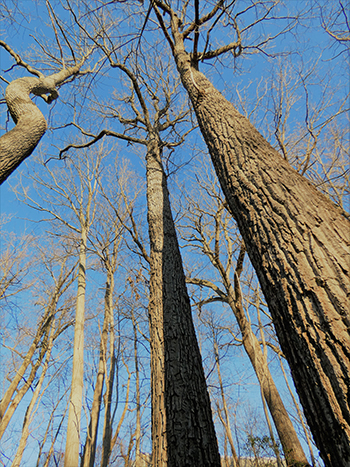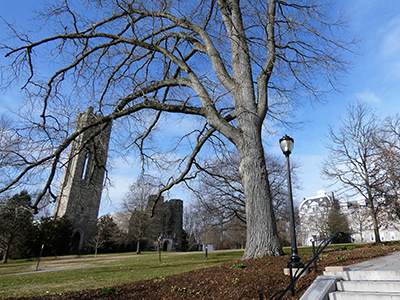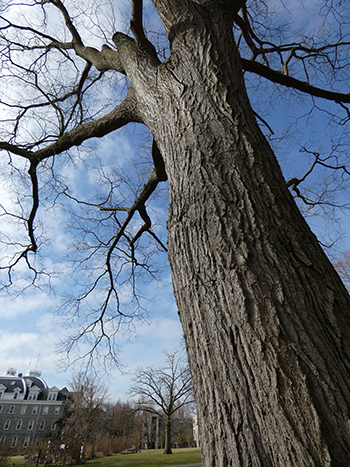
Plants of the Week: February 3

One of my favorite horticultural pastimes in the winter is observing the architecture of trees. While evergreen plants often come to mind first when considering winter interest, the artful forms of deciduous trees can be truly awe-inspiring are just as worthy of attention. Some of my favorite deciduous trees to examine in the winter are oaks (Quercus spp.), with many species boasting an imposing form and interesting bark character.

One of my favorite native oaks for winter interest is Quercus montana (sometimes listed as Q. prinus), the chestnut oak. The leaves are thinner than many Quercus species, with an undulating crenate margin and shallow lobing. Leaves turn yellowish-brown in autumn. The bark of Q. montana is dark-brown to black with highly fissured grooves in between long, broad ridges which become flattened when mature. The epithet montana refers to the mountainous regions where this tree can be found. While known to thrive in dry rocky soils, Q. montana is adaptable to a wide range of soil conditions, preferring moist, rich, acidic, well-drained soil. In typical growing conditions Q. montana will reach a mature size of 50-70 feet tall and wide. The bark is the distinguishing ornamental characteristic feature of this tree; it is truly exceptional and very bold. Though not often found in commercial trade, this oak has great landscape potential. Consider using this oak in your yard as a shade tree. You can find a young specimen off of Whittier Place, behind the Cornell Science and Engineering Library and a number of mature plants growing throughout the Crum Woods in rocky areas. photo credit: R. Payne-Meyer

Another relatively unheralded oak is the swamp white oak, Quercus bicolor. Young trees have an extremely coarse appearance with light brown bark forming numerous rough scales, evolving to grayish-brown with deep furrows and large ridges with age. The bark of mature trees can take on a twisting character. Q. bicolor trees become enormous with age, developing broad trunks and stout branches, with a typical tree maturing to 70 to 80 feet tall and wide. It is not uncommon for open grown trees to be wider than tall. The epithet bicolor refers to the striking contrast between the upper and lower surface of the leaves; the top surface is a dark, shiny green and the underside white. Leaves have 5 to 10 lobes and turn yellow and sometimes reddish-purple in the autumn. This tree is native to lowlands and appreciates moist swampy locations, but is quite adaptable. Q. bicolor can easily be grown in average, acidic medium soil, and has shown impressive drought resistance. Q. bicolor makes an excellent specimen shade tree, displaying interesting bark and form in both its youth and maturity. It is easy to transplant because unlike most oaks it lacks a taproot, further increasing its landscape value. This species is particularly dear to us at the Scott Arboretum as swamp white oaks line the magnificent Magill Walk from the entrance of campus to Parrish Hall. photo credit: R. Payne-Meyer

Another oak I admire for its powerful stature and attractive bark is Quercus rubra, the Northern red oak. Q. rubra is one of the most common oaks growing on the East Coast. The form of Q. rubra takes on a symmetric rounded shape both when young and mature. A mature specimen will reach 50-70 feet tall and wide. The bark on Q. rubra is also distinct, and has a refined look. The bark is dark reddish brown, with shallow vertical fissures between long, rounded ridges with a shiny stripe down the middle. The strong ascending branches of Q. rubra seem to blend the stout, wide, nature of a white oak (Q. alba) with the vase-like form of an elm. The leaves of Q. rubra have 7 to 9 lobes with pointed tips, and turn a deep reddish-brown in autumn. This low-maintenance tree is easily grown in average soils with medium moisture, and can tolerate dry soils and moderate drought; this makes Q. rubra both great shade tree and a durable street tree. You can see an excellent specimen in the green above the Cunningham House. photo credit: R. Payne-Meyer





No Comments